1.
Mae Salong | Santikhiri
Mae Salong is a small town in Chiang Rai Province, in the very north of Thailand, an area known as the Golden Triangle. Situated on a mountain ridge in the Daeng Lao Mountain Chain, the altitude of about 1,100m gives the place a more moderate climate than we know it elsewhere in the sub tropes. The town's original name derives from Doi Mae Salong (Mountain), which peak is close to it. In the 1980s it got renamed to Santikhiri (what means as much as 'Hill of Peace', in contradiction to all the bloodshed which happened here in the decades before). Since the old name is still widely in use and better known than Santikhiri, it will be still used here.
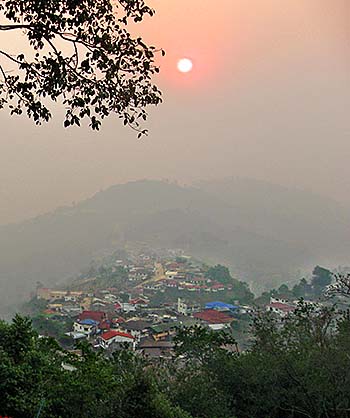
An overview on Mae Salong | Santikhiri from the peak of Doi Mae Salong. The dense haze comes from the many, many fires who burn all around in the Greater Golden Triangle and beyond every year over months. It's a massive impact on the people's health and live quality, not to mention the animals and plants who live in these landscapes. Image by Asienreisender, 3/2007
The place is not old. It was founded only in 1961 by the men of a Chinese regiment under the command of Tuan Shi Wen. Although the inhabitants got the Thai nationality and mixed partially up with Thai women who married into the community, Mae Salong is basically a Chinese village. There are some of this kind in north Thailand, most of them are little known. Mae Salong is certainly the most famous of it's kind, for it became a tourist destination with a number of resorts, hotels and guesthouses. The origin of the local people lies in Yunnan, south China.
2.
A Chinese Place in Thailand
How comes that Chinese soldiers squat in Thailand? Well, after the communist victory in China in 1949 (capturing Kunming in 1950), some 12,000 of the nationalist troops who followed Chiang Khai Chek escaped China and went to Burma, settling down there in the Shan State. The Burmese military, however, proved hostile to them and attacked. After years of struggle, 4,000 Chinese soldiers crossed the border to Thailand (Mae Salong lies just 7km east of the Burmese/Myanmar border). The Thai government granted the immigrants asylum under the condition they would monitor the region in cooperation with the Thai army, who was desperately fighting communist fighters in the large and then more intact forests of north Thailand.
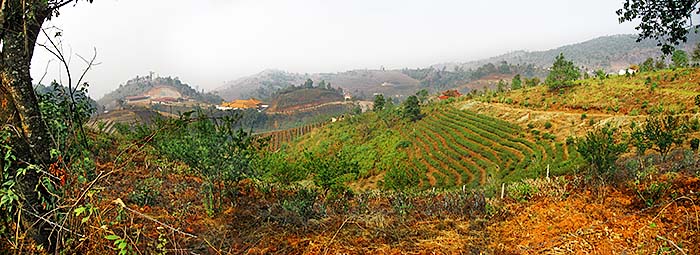
The landscapes around Mae Salong are coined by agriculture, much of it tea plantations. The whole, wider surroundings are all deforested. Image by Asienreisender, 3/2007
3.
Years of Fighting
Bloody struggles were fought in the mountains. Particularly hefty were the fights from 1970 on, when a large, years lasting offensive was launched. Not earlier than in the early 1980s the fights ceased. In 1982, the region was so far pacified. As a reward for their loyalty to the Thai army most of the Chinese in Mae Salong got granted the Thai citizenship (what is generally very difficult to get for non Thai).
4.
Opium and Heroin
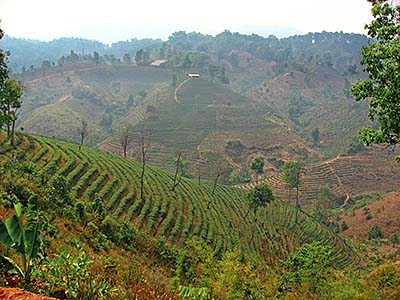
Where grew opium poppies in the past, now tea is cultivated. Image by Asienreisender, 3/2007
To make an income to live from and to buy arms and ammunition from (so far they weren't financed by Thailand, Taiwan and the USA), the locals started growing opium and joined into heroin production (a branch which was very much promoted in the Greater Golden Triangle by the CIA to make extra money in the region while the American Vietnam War). In the early 1970s, Mae Salong had the largest heroin production in Southeast Asia. Not far east of the border, notorious drug warlord Khun Sa of the Shan United Army run another center of opium and heroin production. After the Thai army gained control over the area, there were efforts made by the Thai government to cease the drug production. That was only possible by giving the local producers another source of income. That was then mostly tea, coffee, cherries, corn and other crops. Even wine grows here now. The surroundings of contemporary Mae Salong are coined by large tea plantations. A famous tea from the region is the high mountain oolong, of who 200 tons are produced annually in Chiang Rai Province. To whitewash the place from it's past, Mae Salong was given a new name - Santikhiri.
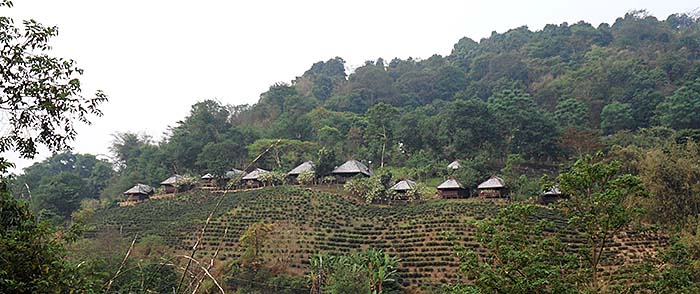
Image by Asienreisender, 4/2012
5.
Tourism
Until the 1980s, Mae Salong was widely cut off the 'rest' of the world. Road building happened late and only from the mid 1990s on the place became one of these insider tips for tourists, particularly backpackers, who were for a long time the avantgarde of tourism. Now, it is a tourist destination, not so much for Westerners but much for Thai and Chinese visitors.
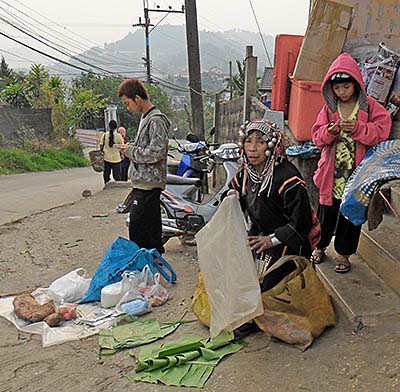
The main tourist 'attraction' are, ridiculously, the hill people. Here an Akha woman. The Akha are the largest ethnic tribal group in many parts of Chiang Rai Province. Image by Asienreisender, 4/2012
It's, by the way, still not so easy to reach Mae Salong without an own vehicle. First time when I came here in early 2007, there was no bus from Pasang at road no. 1 and I had to wait some time and hitch hike. There is anywhere a roadsplit in the mountains where one has to turn right up to Mae Salong. It's a tribal village, inhabited by Akha People, and a military post is placed there. The Thai soldiers there were, as so very often, very helpful and arranged a lift for me up to Mae Salong. An also friendly Thai teacher took me with his car and was so kind to introduce me to his school and his colleagues. I got even opportunity to teach some English to his pupils.
Town and surroundings are great for extensive hikes. If one want's to go further around, what is worth to do, it's possible to rent a motorbike in Mae Salong. In the town's surroundings are many tribal villages.

One of the many tribal villages around Mae Salong. This one has electricity. The haze is terrible. Image by Asienreisender, 3/2007